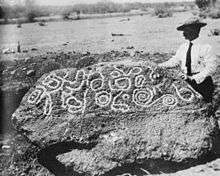Esperanza Stone
The Esperanza Stone was a large (8-feet long) inscribed stone found in the valley of the Yaqui, Mexico. It was discovered and excavated in 1909 by Major F. R. Burnham and Charles Frederick Holder.
Esperanza Stone. Major F. R. Burnham (left), Holder (right), Yaqui Delta, Sonora, Mexico, 1909.
| Hope Stone | |
 Major Burnham standing next to the stone, with the inscription outlined in chalk. | |
| Location | Yaqui River valley |
|---|---|
| Type | stone |
| Material | igneous rock |
| Length | 8 feet (2.4 m) |
| Opening date | 1909 |
Discovery
The stone was discovered during an expedition in the Yaqui valley.
Description
The stone was "a brown, igneous rock, its longest axis about eight feet, and on the eastern face, which had an angle of about forty-five degrees, was the deep-cut inscription."[1] Symbols on the stone include a volute and a swastika, also found on other stones in Mexico.
Legend
There was a legend that the stone had fallen down out of heaven in times past, and that the carving was by human hands.[2]
Meaning of the symbols
Burnham believed that the symbols were Mayan. Others class them as Petroglyphs.[3]
gollark: Prove it by contraposition.
gollark: Ask people for the age they estimate for logos, and the age they estimate other people estimate for logos on average (mean and median).
gollark: We could do a survey.
gollark: 21, probably.
gollark: Due to your lack of Macron implementations, you are simply *unworthy* of serious consideration.
References
- Fort, Charles Hoy (1919). "chapter 11". The Book of the Damned. p. 145. citing Holder, Charles F. (Sep 10, 1910). "The Esperanza Stone". Scientific American: 196. ISSN 0036-8733. (complete article online; retrieved 03 Jan. 2017)
- Lippard, Jim. "Review of The New Inquisition". Retrieved 25 January 2011.
Many years ago a strange stone resembling a meteorite fell into the valley of the Yaqui, Mexico, and the sensational story went from one end to the other of the country that a stone bearing human inscriptions had descended to earth. Hundreds visited the place, natives made a pilgrimage to it from all over Sonora, and the stone, called the Esperanza, became famous in its way, and many of the inhabitants believe that it is a message from heaven, and demand that it be translated.
- Neas, Linda M. Rhinehart (Jan 13, 2011). "About the Native American Indian Pictorial Language". Heather Marie Kosur. Archived from the original on 15 June 2012. Retrieved 25 January 2011.
This article is issued from Wikipedia. The text is licensed under Creative Commons - Attribution - Sharealike. Additional terms may apply for the media files.